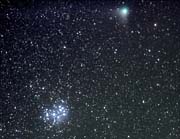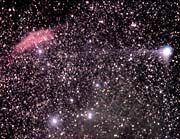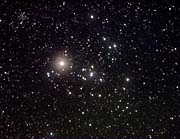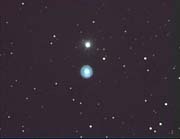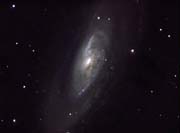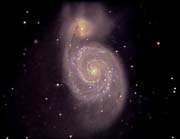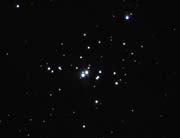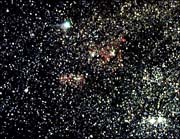The weekend of 7-9 January 2005 and some days after saw the most appalling weather in the North of England and Scotland with winds gusting in excess of 100 mph, floods, power and water supply failures. But there were still occasional quiet spells and I was able on a couple of nights to obtain some more images of Comet Machholz.
The closest pass of the comet to the Pleiades occurred on 7th. January, but a storm was at full strength, with high winds and pouring rain, knocking out the mains electricity supply for 30 hours and washing out the water mains to the town, not fully restored until 14th. January after heroic efforts by the Water Company. The following evening a brief clearance allowed me to snatch an image with my Olympus camera, piggybacked on the Mirage, with the mount running on battery power. Timed at 2025 UST, 270 mm equivalent focal length, 16 seconds at ISO400 .
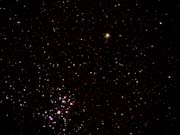
By 10th. January the power was back on although still no mains water, the skies again cleared for a while and the wind moderated. Now with the MX716, first with a 135 mm camera lens, hoping to obtain a decent view of the tails. But because of a less than transparent sky the tails are only visible when the image is heavily processed, hence the noise in this image. Several 1 minute frames at f5.6, median combined using the comet as the focal point, giving slight star trails. The Ion tail points to the left, and the Dust tail downwards.
Over the years I improved my processing techniques, and returned to this image in January 2009, in particular using curves and noise reduction in Photoshop. So now the whole image is smoother without the comet head being 'blown out' . Yes, that is a star just to the right of the comet's core - the core is not fragmented.
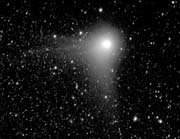
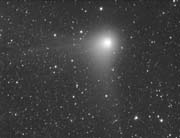
Then I fitted my 35 mm lens. Although the comet was now well away from the Pleiades, the wide field of the lens was able to enclose both objects. I'm quite pleased with this one! Again several frames at f5 median combined, this time 3 minutes each, also 3 minutes for RGB. But the wide field meant that alignment on the stars didn't markedly blur the comet.
This image and the above were taken between 2200 and 2230 UST. Then the clouds rolled in again. There is an interesting asterism of faint (11-12 mag) stars to the left of the comet, which bears a resemblance to a ladies hairpin or 'Kirby Grip'. I hereby name it 'The Hairpin'!! It's aligned N-S, just over 1 degree in length at 3hrs 31min RA, +29deg 45min DEC
